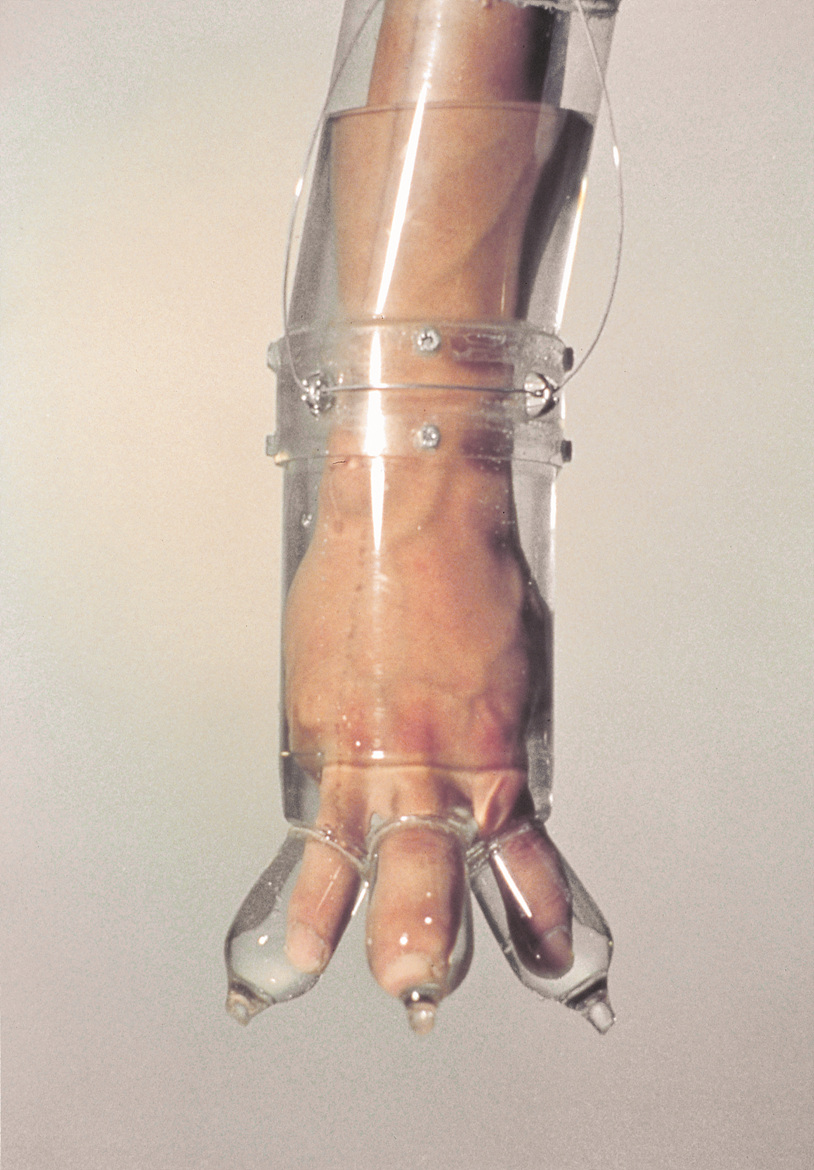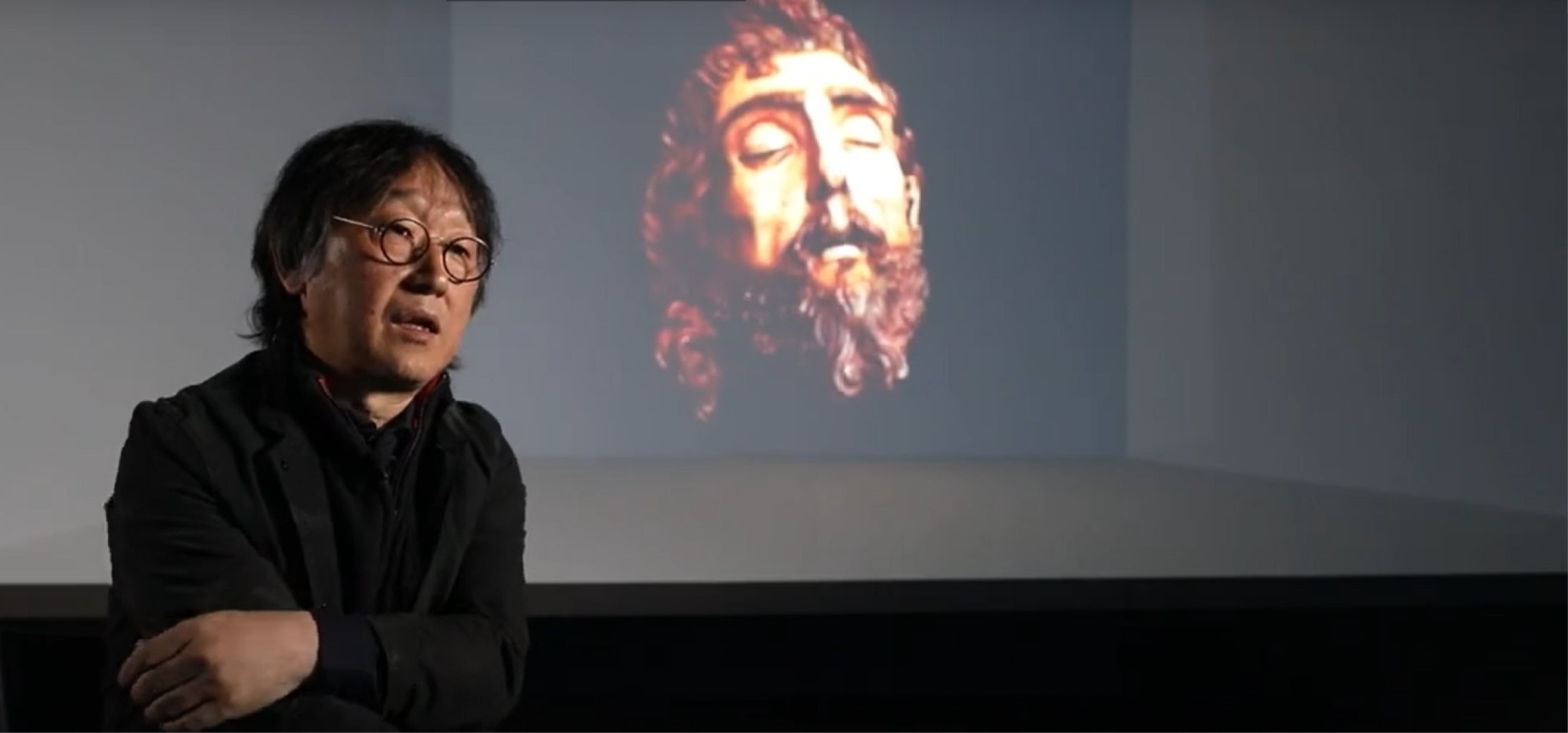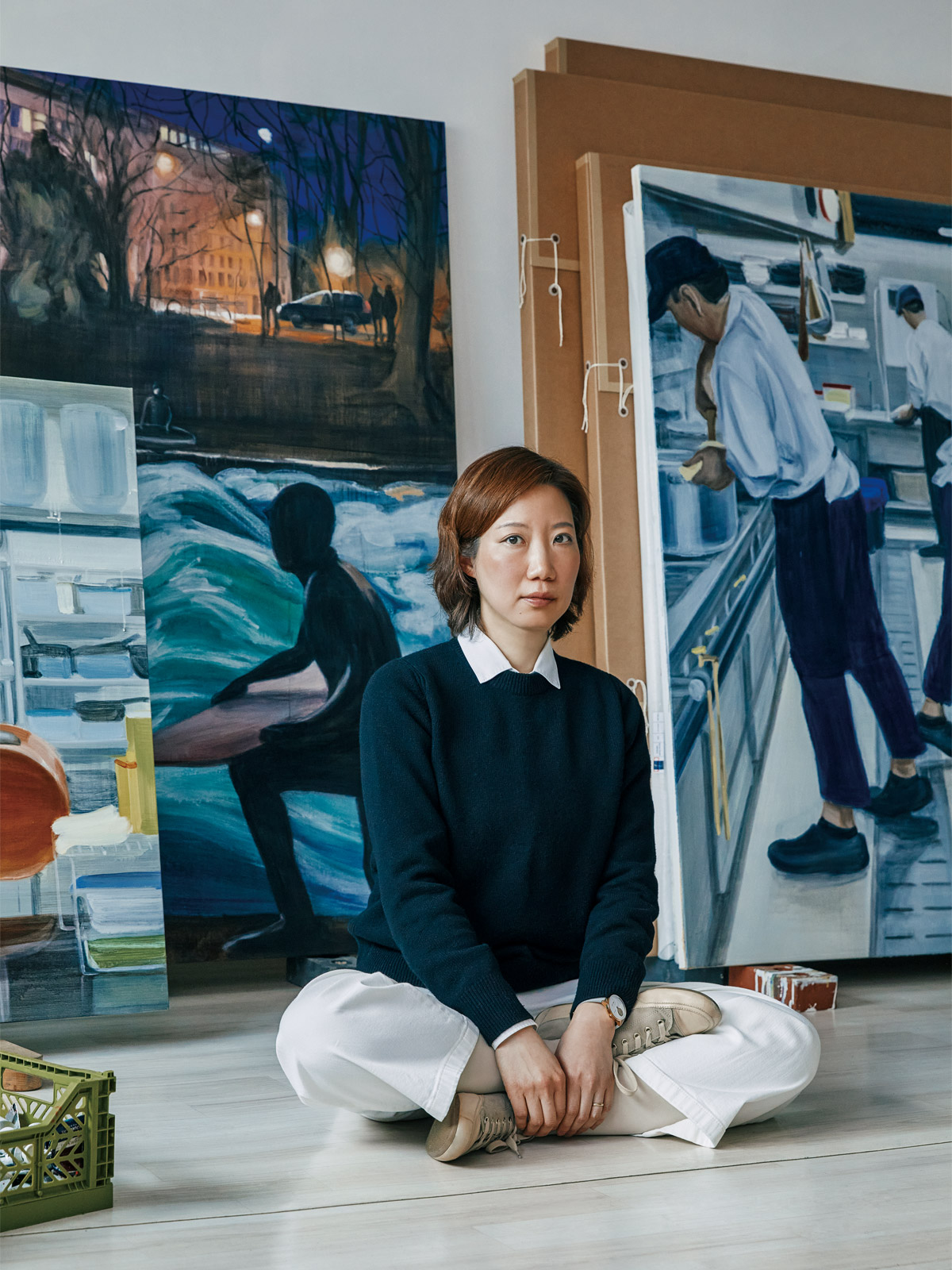Hyungkoo Lee (b. 1969) has been producing a diverse body of work on the theme of the ‘body’ for the past 20 years. The artist has been experimenting with the transformation, distortion, and expansion of the body by mobilizing scientific fields such as anatomy along with his artistic imagination. His work may look like a scientist's experiment, but it is an artistic experiment that mobilizes the artist's imagination and curiosity, which is why he often describes himself as a 'pseudo-scientist'.
 Hyungkoo Lee,Enlarging My Right Hand with Gauntlet 1,
2002, C-print, 160 x 120cm ©Artist
Hyungkoo Lee,Enlarging My Right Hand with Gauntlet 1,
2002, C-print, 160 x 120cm ©ArtistLee's preoccupation with the body as a subject can be traced back to his early series The Objectuals. While studying abroad in the United States, Lee experienced the differences between Western and Asian bodies, which led him to create devices that can be worn on the head, hands, and other parts of the body to transform the human body into any desired size or shape.
 Hyungkoo Lee, Altering Facial Features
with H-WR, 2007 ©Busan
Museum of Art
Hyungkoo Lee, Altering Facial Features
with H-WR, 2007 ©Busan
Museum of ArtIn Altering Facial Features with H-WR (2007), the artist wears a helmet with optical film and lenses that abnormally enlarge certain parts of the face, such as the eyes and mouth. These alterations are made according to Westernized beauty standards and the criteria for a good physiognomic face, resulting in an outcome that is unnaturally bizarre. The artist accentuated the artificial image by adding a painted black hairline and inserting aluminum foil into the teeth.
 Hyungkoo Lee, Felis Animatus &
Leiothrix Lutea Animatus, 2009 ©Busan
Museum of Art
Hyungkoo Lee, Felis Animatus &
Leiothrix Lutea Animatus, 2009 ©Busan
Museum of ArtOne day, the image of a face with
abnormally large eyes from ‘The Objectuals’ series reminded him of a
cartoon character, and he began to imagine what kind of skeletal structure such
a creature would have, which led him to start the ‘ANIMATUS’ series.
While his previous work was an
experiment in body modification, the ‘ANIMATUS’ series is a study of
anatomy to reshape the skeletons of fictional cartoon characters and express
their dynamic and playful gestures. Since cartoon characters are fictional
creatures rather than real animals, the artist's imagination was naturally
involved in the realization of their skeletons. For example, instead of using
facial muscles, which animals don't have, the artist used the bones themselves
to create playful facial expressions.
 Hyungkoo Lee,Enlarging My Right Hand with Gauntlet 1,
Canis D Animatus(muscle attachment), 2015, Resin, Glass, Oil
paint, 139 x 96 x 44.5cm, Pedestal 12 x 140 x 70cm ©Artist
Hyungkoo Lee,Enlarging My Right Hand with Gauntlet 1,
Canis D Animatus(muscle attachment), 2015, Resin, Glass, Oil
paint, 139 x 96 x 44.5cm, Pedestal 12 x 140 x 70cm ©ArtistBy giving Tom, Bugs Bunny, Donald Duck, Road Runner, and Coyote an anatomically based body, he creates the illusion that these fictional characters, which only exist in cartoons, are real as if they were living beings in their own right.

이형구, 〈Fish Eye Gear〉, 2010 ©두산아트센터
Lee's ‘Eye Trace’ series was
born out of his ongoing interest in the animal body and his curiosity about how
the world is viewed by the many creatures on Earth. As an answer to his
curiosity, he decided to become an animal himself and see the world through
their eyes in the ‘Eye Trace’ series.
In the case of Fish Eye
Gear (2010), which was created to experience the perspective of a
fish, the artist made a suit with a closed front and lenses on the sides that
resembled a fish's eye structure, and walked around the space wearing it.
Moving according to the fish's vision, the artist soon realized that he was
walking in a zigzag like a fish, meaning that his gaze influenced his movement
and resulted in a characteristic motion.
 Hyungkoo Lee, MEASURE,
2014 ©Busan Museum of Art
Hyungkoo Lee, MEASURE,
2014 ©Busan Museum of ArtFollowing the ‘Eye Trace’ series, Lee introduced the series ‘MEASURE’ (2014), which studies the movement of horses according to their vision. In the beginning of the series, Lee used a wide-angle viewfinder to realize the visual structure of a horse that cannot see straight ahead as in the ‘Eye Trace’ series, but in his later works, Lee focuses more on movement than on the horse's vision.

M 02, 2014, Pencil, Water color pencil on paper, Framed, 220 × 150㎝
Inspired by the graceful movements of horses in dressage competitions, the artist studied the posterior body structure of horses and mounted a device with a similar structure on his own body to recreate their movements. The artist attached a horse's tail to the device to make it look like a real horse was running, and the horse's movements were learned and reproduced as they are in real dressage, not randomly. Furthermore, the artist developed the process of transcribing the rhyme of the hoofbeats recorded in the video into a musical score.
 Hyungkoo Lee, X variation,
2021 ©DOOSAN Art Center
Hyungkoo Lee, X variation,
2021 ©DOOSAN Art CenterHaving explored and reinterpreted the
body's external organs, the artist turns his attention to the more microscopic
realm of the body's interior in the ‘X’ series. In X
variation (2021), the interior of the body straddles the boundary
between figuration and abstraction, creating a bizarre landscape that appears
to be a microcosm.
The work was born out of the artist's
concern about how to represent the modern human body. In response, the artist aims to represent the
'impure human body' of modern individuals who live with foreign substances,
such as metal rods inserted into bones or dental implants embedded in gums,
using a variety of materials.
 Hyungkoo Lee, X variation,
2021 ©DOOSAN Art Center
Hyungkoo Lee, X variation,
2021 ©DOOSAN Art CenterThe resulting X variation
is a harmonious collision of polyurethane foam that resembles flesh, paper
mache that reveals the texture of bone, cold and sharp metal, and circular
materials that float in space, creating a unique human landscape.
These experiments with the body stem
from the artist's curiosity to perceive and understand the world in a different
way. His interest in the human body, from his own to the bodies of other species
and fictional creatures on Earth, stems from his desire to understand and know
more about himself, others, and the world.
“What does the world look like through
the eyes of crawling insects? What does the world look like through the double
eyes of a flying dragonfly? Is what I see the right form? Maybe it's not when
you look at it closely.
I have to keep doubting and reflecting
in my own eyes, on what I think I know. If gaze is a problem, it's important to
look at it from the other person's point of view. After all, isn't it just a
matter of fighting because of different points of view? From the other person's
point of view, it's nothing.” (Top Class, Interview with Hyungkoo Lee)
 이형구 작가 ©월간미술
이형구 작가 ©월간미술Hyungkoo Lee received a bachelor’s
degree in sculpture from Hongik University and a master’s degree in sculpture
from Yale University. He has held solo exhibitions at Busan Museum of Art
(2022, Busan); P21 (2019, Seoul); Perigee Gallery (2015, Seoul); the
Polytechnic Museum (2015, Moscow); DOOSAN Gallery (2010, Seoul); the Natural
History Museum Basel (2008, Basel); and Arario Gallery (2008, New York). And, he
had the first solo exhibition in the Korean Pavilion at the 52nd Venice
Biennale (2007).
He has participated in numerous group
shows including those held at the Jeonbuk Museum of Art (2020, Wanju); the Aram
Nuri Arts Center (2019, Goyang); the Holden Gallery (2018, Manchester); the
Donuimun Museum Village (2018, Seoul); the Buk-Seoul Museum of Art (2018,
Seoul); the Daejeon Museum of Art (2018, Daejeon); the National Museum of
Modern and Contemporary Art, Korea (2017, Seoul); Vestfossen Kunstlaboratorium
(2016, Vestfossen); Daegu Art Museum (2015, Daegu); Choi & Lager Gallery
(2015, Cologne); and PLATEAU, Samsung Museum of Art (2014, Seoul).




















